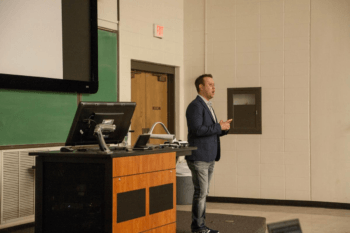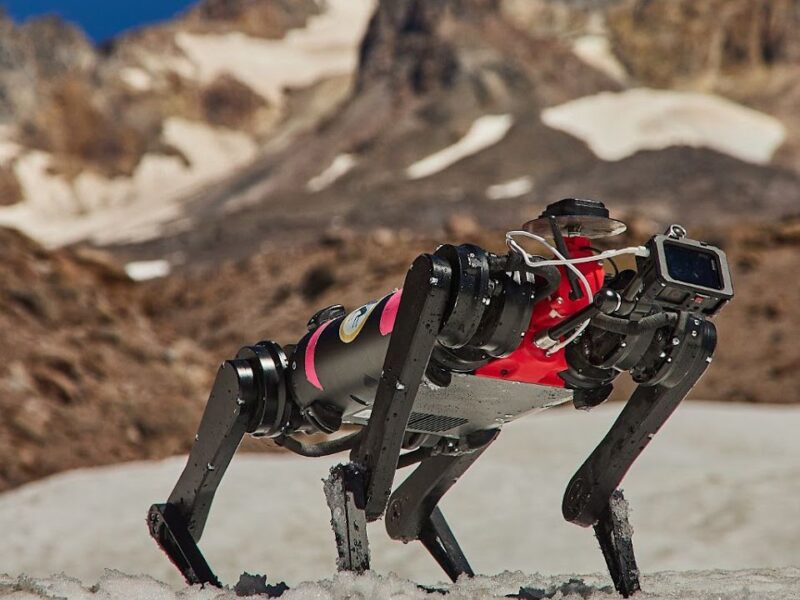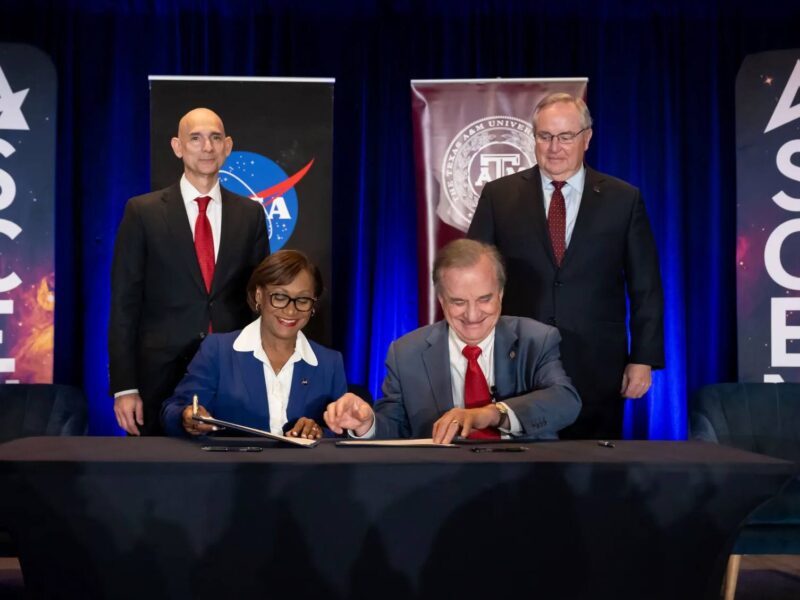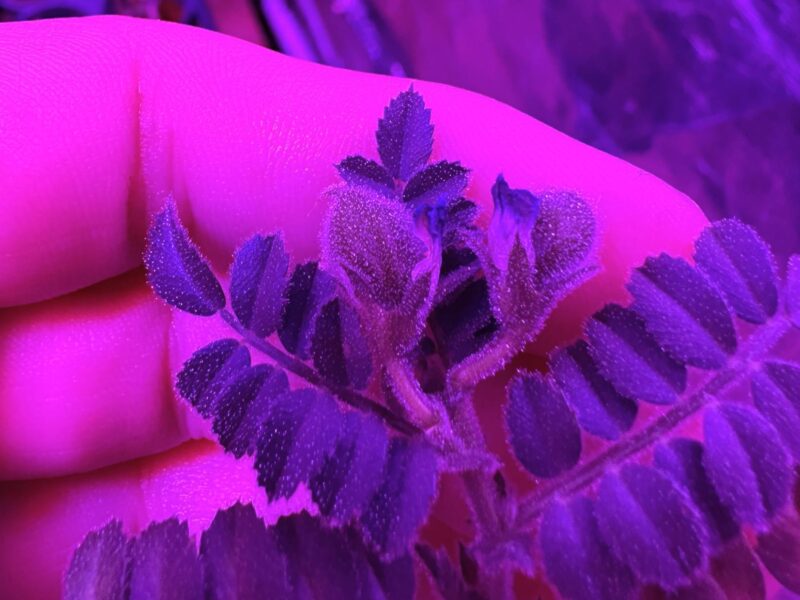Aggies At NASA: Having Fun And Great Careers At Warp Speed

Josh Byerly figures he may have one of the best jobs on planet Earth and maybe even above it.
Byerly serves as a public affairs officer and also as “the voice of Mission Control,” and is one of many Texas A&M University graduates currently employed at NASA.
Besides providing NASA with scores of engineers and flight technicians, several Aggies have served as true astronauts. For the record, the first Aggie in space was William Pailes, who earned a master’s degree in computer science from Texas A&M in 1981 after graduating from the Air Force Academy.
Pailes flew on the shuttle mission STS-51J on Atlantis in October of 1985, the maiden voyage of Atlantis. By the end of the mission, Pailes had traveled more than 1.6 million miles and logged 97 hours in space.
No doubt the most famous Aggie in space is Mike Fossum, a 1980 mechanical engineering graduate. His most recent trip to space was last year as a member of the International Space Station in which he stayed in space for about six months while serving as commander of Expedition 29.
His previous space flight experience included the shuttle missions STS-121 in 2006, which was a return-to-flight test mission and assembly flight to the space station, and STS-124 aboard Discovery in 2008, which was the 123rd space shuttle flight and the 26th shuttle flight to the space station. He began his career at NASA in 1993 as a system engineer and was selected as an astronaut in 1998.
But exactly how many Aggies work at NASA is not quite known.
“I am told there are hundreds of Aggies here, and nobody seems to know the precise number,” Byerly says from his Houston office. “But when you talk about the Aggie family, we certainly have a big one here.”
A 1999 Texas A&M graduate, Byerly says working at NASA “is a great job because you get to touch and witness history every day. This agency and the people that work here are pursuing a bold mission, and to be able to be one of the faces and voices that tells that story to the public is an honor.”
“NASA has a lot in common with the experience you get in Aggieland,” he adds.
“It’s one big family and you get to share an incredible bond with the people that are here.”
It’s certainly not your usual ho-hum desk job.
For instance: Byerly says one day he found himself sitting between the late Neil Armstrong and Gene Cernan in a meeting.
“So here’s the first man to walk on the moon and the last man to walk on the moon, and they’re having this conversation about effective methods for landing on a planetary surface, across from me,” he says.
He also recalls when Aggie astronaut Mike Fossum landed from his latest trip aboard the International Space Station, and it was bitterly cold at the landing site in Kazakhstan.
“The temperature was about minus-15 degrees, and he was landing right as the sun was coming up,” Byerly says. “We were in our helicopters hovering near the landing zone, and I looked out the window and saw the plasma trail from his spacecraft as it was re-entering. It was this giant ‘V’ that was pink, orange, blue and yellow, like the wake off of a boat. Fifteen minutes later, they pulled Mike and the rest of the crew out of the capsule, and I got to say howdy to my friend. So here’s two Aggies, standing in the middle of nowhere,” one of which just landed from space. Pretty incredible.”
Before joining NASA, Byerly worked at several PR jobs in the Dallas area, and he started his career as a general assignments reporter for KBTX-TV, the CBS affiliate in the Bryan-College Station area.
“It was that real-world experience that set me on the course for where I am now, so I’m thankful for it,” he adds. “I don’t think anything can prepare you for doing a space shuttle launch and landing, but my time in College Station really did set me on the course for the rest of my life.”

Laura Kearney can relate to that. She earned bachelor’s and master’s degrees from Texas A&M in 1990 and 1992, and joined NASA shortly after graduating, serving in the agency’s Space Life Sciences department, then moving to Shuttle Support, Advanced Space Suit Development and today serves in the Orion Crew and Service Module Development areas.
What does she like best about working at NASA?
“It’s being part of a group of hardworking, dedicated people that are all coming together to do great things,” she explains. “I’ve spent a lot of time as a space suit test subject, testing various new development configurations of the suit. The most exciting experience I had as a suit subject was doing a test run in the Neutral Buoyancy Laboratory, testing a new space suit being developed specifically for small women. I’ve also made several flights on the zero-gravity aircraft.”
She says that one of her most challenging assignments was supporting the Shuttle-Mir Program in the mid-1990s and learning how to work closely with the Russians.
“I think Texas A&M prepared me well for this job,” she believes. “The biomedical engineering program exposed me to a wide array of engineering disciplines, which is important now that I am managing a team with diverse backgrounds and expertise. It’s really great to see the next generation of young Aggies coming into the NASA workforce. They are technically competent, dedicated and ready to take the next big leap in space exploration.”

Paul Hill earned a bachelor’s degree in aerospace engineering in 1984 and a master’s degree in 1985 and serves as director of Mission Operations, a job that is wide ranging and far reaching and exciting.
“For me, the best thing about working at NASA is contributing to something that has such strong historical and global significance, and being able to see the difference that I am able to make in that kind of endeavor,” Hill says.
“As one of the original ISS (International Space Station) flight directors, I had the opportunity to work with a small group of American and Russian electrical experts and a veteran Russian flight director named Yuri Budnik while studying a Russian electrical system problem in the first year of orbit operations. This problem threatened survival of the spacecraft when we had just started building it in orbit. In just a couple of months, we went from sparring over position to being a closely integrated joint team, with the American and Russian sides both contributing to engineering a solution.
“Not only did we slow down the deterioration of the electrical system, but we were then able to rebuild it during the next visit to ISS, with our Russian colleagues giving the American participants much of the credit.”
As the lead flight director for the return-to-flight after the 2003 Columbia tragedy, Hill led the team that developed methods to detect and repair orbiter damage in flight, then went on to demonstrate those and several other new operations during the flight on shuttle mission STS-114 with stunning success.
“My Aggie aerospace engineering education certainly taught me what I needed to know to contribute among the rocket scientists here,” Hill confirms.
“My experiences in the Corps of Cadets and later in the Air Force also helped give me the confidence to take on more and more responsibility. It was a great discovery for me that the values and culture in the mission control world at Johnson Space Center are very similar to those found in Aggieland.”
Media contact: Keith Randall, Texas A&M News & Information Services.





